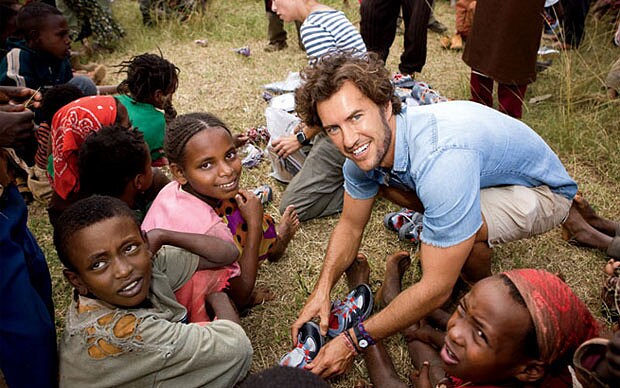TOMS Shoes is a revolutionary footwear company that has changed the game in the fashion industry. Founded in 2006 by Blake Mycoskie, TOMS set out to create a business model that would not only provide stylish and comfortable shoes but also address the issue of poverty and poor health conditions in developing countries.

The company’s innovative approach to corporate social responsibility has made it a leader in sustainable fashion and a role model for other companies looking to make a positive impact on the world. TOMS’ mission is simple yet ambitious: for every pair of shoes sold, the company donates a new pair to a child in need.
This “One for One” philosophy has been the driving force behind TOMS’ success, providing over 90 million pairs of shoes to children in more than 70 countries around the world. By partnering with organizations such as non-profits, NGOs, and governments, TOMS ensures that its donated shoes reach those who need them most, including children living in poverty, victims of natural disasters, and individuals affected by conflict and war.

But TOMS’ commitment to making a difference doesn’t stop at donations. The company takes a holistic approach to sustainability, considering every aspect of its operations when it comes to minimizing its environmental impact. From using eco-friendly materials in their shoes to reducing waste in their supply chain, TOMS continuously strives to improve its practices and promote ethical manufacturing standards.
The impact of TOMS’ efforts extends beyond just the recipients of its donated shoes. By creating jobs and supporting local communities, the company helps to stimulate economic growth and break cycles of poverty. Additionally, through its advocacy work, TOMS raises awareness about global issues such as education, health, and human rights, inspiring others to take action and make a difference.
Blake Mycoskie, founder of TOMS, has also received several accolades for his vision and leadership. He was named one of Fortune’s “Top 10 Entrepreneurs” and was awarded the “Award for Corporate Social Responsibility” by the United Nations.
Despite its success, TOMS faces challenges in maintaining its commitment to sustainability and social responsibility while still meeting consumer demand. The company must constantly balance its desire to help those in need with the financial realities of running a business.
The company was taken over by its creditors: Jefferies Financial Group Inc, Nexus Capital Management LP, and Brookfield Asset Management Inc in December 2019, and founder Mycoskie ceased to be an owner.
However, TOMS continues to push forward, finding creative solutions to these challenges and setting an example for other companies to follow. Through its dedication to ethical practices and sustainability, TOMS is helping to shape a better future for generations to come.
In conclusion, TOMS Shoes is a shining example of what can be accomplished when businesses prioritize social responsibility and sustainability. With its innovative “One for One” model, commitment to ethical practices, and passion for making a difference, TOMS is changing the face of the fashion industry and inspiring others to do the same.
Marketing Strategies of TOMS Shoes
In the realm of contemporary commerce, TOMS Shoes stands out for more than just its footwear. The brand’s marketing strategies are not merely transactional; they represent a global movement centered around the groundbreaking “One for One” model. This unique approach, seamlessly blending business with social responsibility, has propelled TOMS into a league of its own. Join us as we dissect the core elements of TOMS’ marketing strategies, where purpose-driven storytelling, social impact, and community engagement converge to redefine the conventional boundaries of brand success –
1. One for One Model
TOMS Shoes isn’t just about stylish footwear; it’s about walking the walk of social responsibility. Their signature “one for one” model has resonated deeply with consumers, becoming a potent marketing strategy and a driving force behind their success.
At the heart of this model lies a simple yet powerful idea: For every pair of shoes bought, another pair is donated to a child in need. Founded by Blake Mycoskie after witnessing barefoot children in Argentina, TOMS transformed shoe shopping into a conscious act of giving. This direct link between purchase and positive impact resonated with customers seeking brands that align with their values.
The “one for one” effect goes beyond boosting sales and brand image. It has left a lasting positive impression on customers, fostering loyalty and advocacy. Moreover, it has inspired a movement within the business world, encouraging companies like Warby Parker and Bombas to embrace social good alongside profitability.
2. Storytelling and Cause Marketing
TOMS Shoes understands that a powerful story can bridge the gap between consumers and a brand’s mission. Their narrative of social impact isn’t just a marketing tactic; it’s the very fabric of their identity. By weaving in their “one for one” model and the positive change it creates, TOMS invites customers to become part of something bigger than themselves.
This storytelling manifests in multiple ways. Collaborations with celebrity advocates who champion charitable causes spread awareness organically through social media, capturing the attention of a wider audience. Engaging customer interactions are encouraged, allowing representatives to explain the brand’s story and the significance of each purchase. Even their target audience, dubbed the “TOMS rebel optimist,” reflects their commitment to positive change through conscious lifestyle choices.

TOMS doesn’t simply tell its story; it offers people a way to participate. Their website provides a platform for direct engagement, empowering individuals to send messages of support and connect with the communities they’re impacting. This interactive approach fosters a sense of belonging and purpose, transforming customers into brand ambassadors who carry the TOMS story forward.
3. Social Media Engagement
In the digital age, social media is a vital dance floor for any brand wanting to connect with its audience, and TOMS Shoes knows these steps by heart. Their social media strategy isn’t just about selling shoes; it’s about igniting engagement and amplifying their social impact message.
One way they achieve this is through interactive campaigns, like the iconic “One Day Without Shoes” initiative. This challenge transforms a simple photo with bare feet into a symbol of solidarity and action. For every picture shared, TOMS donates a pair of shoes, blurring the lines between consumer and changemaker. Similarly, their Instagram challenges empower people to become part of the brand’s story, their footprints leaving a digital trail of awareness.

TOMS doesn’t shy away from leveraging the power of celebrity partners. When a renowned name posts a picture wearing their shoes, it’s like instant, global “free advertising.” But it’s more than just brand exposure; it’s about humanizing their mission and reaching new audiences who might not be familiar with their “one for one” model.
Beyond celebrity buzz, TOMS uses social media strategically. Compelling new season imagery, supported by high-street window displays, creates a seamless blend of online and offline engagement. This multi-channel approach keeps their brand fresh in the minds of consumers while reinforcing their commitment to social good.
4. Collaborations and Limited Editions
TOMS Shoes understands that synergy can spark magic. Collaborations and limited editions aren’t just marketing tactics; they’re harmonious duets between TOMS’ values and the creative visions of like-minded partners. This strategic approach unlocks fresh avenues for revenue and awareness, while reducing marketing and distribution costs.
Imagine pairing the iconic TOMS slip-on with the vibrant world of Marvel superheroes, the chic designs of Batsheva, or the playful prints of Once Upon a Farm. These aren’t just limited-edition collections; they’re opportunities to engage new audiences and amplify TOMS’ social impact message. Each collaboration brings a unique perspective, injecting a dose of excitement into the brand while staying true to its core values.


But the collaboration stage doesn’t just host big names. TOMS extends its hand to local communities, working with them to co-create authentic designs and products that celebrate their stories and empower their artisans. This approach fosters meaningful connections on a global scale, weaving diverse threads into the rich tapestry of the TOMS brand.
5. Retail Experience
TOMS Shoes crafts a retail experience that transcends mere shopping, immersing customers in the heart of their social mission. Their stores aren’t just about selling shoes; they’re about sparking empathy, igniting action, and leaving a lasting impression.
Step into a TOMS store, and you’re greeted by interactive displays showcasing the impact of their “one for one” model. Walls adorned with photos of smiling children wearing donated shoes tell a powerful story, not just of a product, but of the lives transformed by each purchase. This visual storytelling fosters a connection between customer and cause, reminding them that their choice has a tangible impact.

But the experience doesn’t stop there. TOMS encourages engagement and exploration. Customers can participate in interactive activities, learn more about the communities they’re helping, and even write messages of hope to be sent with donated shoes. This transformative environment turns shoe shopping into a conscious act of giving, empowering customers to become active participants in the brand’s mission.
6. Community Building
TOMS Shoes isn’t just a brand; it’s a catalyst for connection and positive change. Their commitment to community building extends far beyond their iconic “one for one” model, weaving a vibrant tapestry of partnerships, purpose, and shared impact.
At the heart of their approach lies collaboration with over 100 Giving Partners in 70 countries. This network isn’t just about distributing shoes; it’s about integrating footwear into holistic community development programs. This ensures the impact goes beyond a single pair, addressing broader needs like healthcare, education, and economic empowerment.
But TOMS doesn’t simply partner; they build meaningful relationships. Volunteer opportunities, community celebrations, and ongoing support initiatives foster deeper connections with the communities they serve. This collaborative spirit ensures sustained impact and empowers local voices to drive change from within.
The commitment to community extends to their internal practices. As a Certified B Corporation™, TOMS adheres to the highest standards of social and environmental responsibility. This transparency and accountability demonstrate their dedication to making a positive difference not just through their products, but through every facet of their operation.
TOMS Shoes has walked a path less traveled, where style and social impact dance hand-in-hand. By weaving storytelling, cause marketing, community building, and innovative retail experiences into the fabric of its existence, TOMS has redefined marketing as a force for good. In a world yearning for authenticity and purpose, TOMS offers more than just footwear; it offers a journey of compassion, a reminder that every step we take, together, can leave a lasting footprint on the world.
Marketing Mix of TOMS Shoes
TOMS Shoes has built a global brand synonymous with conscious consumerism and impactful social giving. Let’s dissect their success story through the lens of the marketing mix (4Ps), exploring each element in intricate detail:
1. Product:
Core offering: Comfortable, stylish canvas shoes in a variety of designs and colors for men, women, and children.
Product differentiation: “One for One” model – for every pair purchased, another pair is donated to a child in need. This creates a strong emotional connection and unique selling proposition.
Limited editions and collaborations: With brands like Marvel, Jennifer Garner, and West Elm, these partnerships generate excitement, attract new audiences, and reflect TOMS’ values.
Sustainable materials: Use of organic cotton, recycled materials, and environmentally conscious practices aligns with consumer values and resonates with their mission.
Expanding product lines: Beyond shoes, TOMS offers sunglasses, eyewear, and accessories, leveraging their brand recognition and diversifying their revenue streams.
2. Price:
Premium pricing: TOMS shoes are priced slightly higher than average canvas shoes, reflecting their quality, brand value, and social impact.
Competitive strategy: While not the cheapest option, TOMS offers good value for the price, considering the quality and the charitable aspect.
Promotional pricing: Occasional sales and special offers provide price incentives without compromising their premium positioning.
Focus on long-term value: The durable nature of the shoes coupled with the “one for one” impact reinforces the perceived value proposition.
3. Place:
Omnichannel distribution: Customers can purchase TOMS online, through their own stores, partner retailers, and department stores, ensuring widespread availability.
Direct-to-consumer focus: Online store and flagship stores provide greater control over brand experience and communication.
Strategic partnerships: Collaboration with ethical retailers and brands aligns with TOMS’ values and expands their reach to like-minded consumers.
Community presence: Participation in social events, pop-up shops, and charitable initiatives creates a strong community connection and brand visibility.
4. Promotion:
Storytelling and cause marketing: Focus on the “one for One” model and stories of the children impacted builds emotional connection and brand purpose.
Celebrity endorsements and collaborations: Partnerships with influential figures increase brand awareness and attract new audiences.
Social media engagement: Active presence on platforms like Instagram and Facebook fosters community involvement and drives brand interaction.
Interactive campaigns: “One Day Without Shoes” initiative encourages user-generated content and promotes social advocacy.
Public relations and earned media: Leveraging positive media coverage and customer testimonials reinforces brand credibility and reputation.
Influencer marketing: Collaborating with micro-influencers who align with their values generates authentic recommendations and reaches a targeted audience.
TOMS’ success lies in its unique blend of product differentiation, value-driven pricing, strategic distribution, and impactful communication. By weaving social purpose into every thread of their marketing mix, TOMS has transformed shoe shopping into a conscious act of giving, leaving footprints of impact and inspiration on the world stage.
Also Read: Success Factors: What Makes Foot Locker Inc. So Successful?
To read more content like this, subscribe to our newsletter



